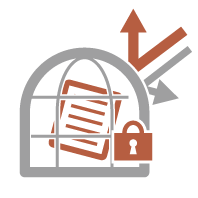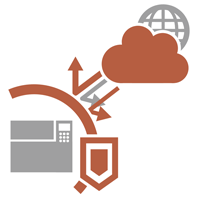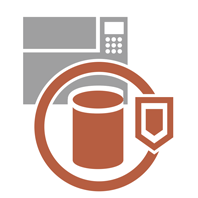
Various Security Functions
Do you feel uneasy about the following problems?
Unattended output
Unauthorized access
Forgetting to erase confidential data on the machine
The machine provides various security functions for minimize the risk of information leakage and unauthorized access.
This section describes functions that are effective in certain situations.
This section describes functions that are effective in certain situations.
 |
Implementing security measures does not guarantee that all information will be protected. |
 |
Using the Import All function enables multiple devices to be managed with the same settings. Importing/Exporting the Setting Data |
Preventing Documents Leaks
 | When managing confidential documents, it is necessary to handle problems such as leaks and loss. The machine has a security function that prohibits printing until the user logs in at the device, in order to prevent the leakage or loss of documents. Use the following functions as security measures for preventing document leaks. |
Force Hold
To avoid leaving printed material, accidental information leakage, misprinting, etc., the administrator can set to store the document before printing. Printing Documents Held in the Machine
Only Allow Encrypted Print Jobs
By using Encrypted Secure Printing, you can send encrypted printing data to a machine from your computer. This enables you to reduce the risk of information leaks when sending printed data, and to print more safely. Forced Hold Settings
Preventing Unauthorized Access to the Network
 | Although Cloud services have made it easier to exchange data via the Internet, communication can still be intercepted or modified by malicious third parties due to network vulnerabilities. The machine provides various measures for increasing network security, such as only allowing communication with specific IP addresses and encrypting data for communication. Use the following functions as security measures for preventing unauthorized network access, etc. |
Firewall Settings
Unauthorized access by third parties, as well as network attacks and breaches, can be blocked by only allowing communication with devices that have a specific IP address. Restricting Communication by Using Firewalls
Proxy Settings
You can provide greater security by using a proxy server for connections outside the network. Setting a Proxy
TLS Settings
TLS is a protocol for encryption for data sent over a network and is often used for communication via a Web browser or an e-mail application. TLS encrypted communication enables secure network communication when accessing the machine using the Remote UI. Configuring the Key and Certificate for TLS
IPSec Settings
While TLS only encrypts data used on a specific application, such as a Web browser or an e-mail application, IPSec encrypts the whole (or payloads of) IP packets. This enables IPSec to offer a more versatile security system than TLS. Configuring the IPSec Settings
IEEE 802.1X Settings
If a device tries to connect and start communicating on an 802.1X network, the device must go through user authentication in order to prove that the connection is made by an authorized user. Authentication information is sent to and checked by a RADIUS server, which permits or rejects communication to the network depending on the authentication result. If authentication fails, a LAN switch (or an access point) blocks access from the outside of the network. The machine can connect to an 802.1X network as a client device. Configuring the IEEE 802.1X Authentication Settings
Preventing Leaks of Confidential Information during Operation of the Machine
 | The machine generates value as an information asset by storing important data. Preventing confidential information from remaining on the machine after disposal is another important security measure. The machine provides various measures for increasing security of operation, such as preventing unregistered users from operating the machine, and completely erasing temporary job data when the machine is started. Use the following functions as security measures for preventing leaks of confidential information during operation of the machine. |
Verify System at Startup
The integrity of the firmware, system, and AddOn applications in the machine is verified during startup. <Verify System at Startup>
McAfee Embedded Control
When the machine is operating, the McAfee Embedded Control function is used to prevent unauthorized program modification and the execution of unauthorized programs, for improved system reliability. <McAfee Embedded Control>
Personal Authentication Management
A user name and password can be used to perform personal authentication of users. Preventing unauthorized access by third parties and setting usage restrictions can maintain a higher level of security and enable more efficient operation of the machine. Managing Users
Initialize All Data/Settings
You can restore all of the machine settings to the factory default values. Since data remaining in the memory is overwritten with meaningless values, this prevents external leaks of confidential data when disposing of the machine. Initializing Settings
Security Policy Settings
A security policy describes company-wide rules regarding information security. With this machine, multiple settings related to a security policy can be set together. Applying a Security Policy to the Machine
Allow Use of Default Password for Remote Access
You can set the machine to not allow users to log in to the Remote UI using the default password (7654321) of the "Administrator" user for security reasons. Setting an Authentication/Password Policy